Related Research Articles

Hannah Wilke (born Arlene Hannah Butter; was an American painter, sculptor, photographer, video artist and performance artist. Her work is known for exploring issues of feminism, sexuality and femininity.
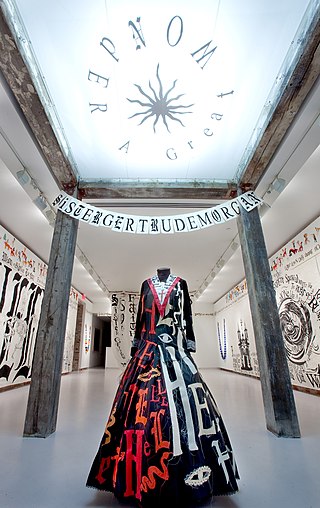
Lesley Dill is an American contemporary artist. Her work, using a wide variety of media including sculpture, print, performance art, music, and others, explores the power of language and the mystical nature of the psyche. Dill currently lives and works in Brooklyn, New York.

Zoe Strauss is an American photographer and a nominee member of Magnum Photos. She uses Philadelphia as a primary setting and subject for her work. Curator Peter Barberie identifies her as a street photographer, like Walker Evans or Robert Frank, and has said "the woman and man on the street, yearning to be heard, are the basis of her art."
Carole Caroompas was an American painter known for work which examined the intersection of pop culture and gender archetypes.
Peter Ford Young is an American painter. He is primarily known for his abstract paintings that have been widely exhibited in the United States and in Europe since the 1960s. His work is associated with Minimal Art, Post-minimalism, and Lyrical Abstraction. Young has participated in more than a hundred group exhibitions and he has had more than forty solo exhibitions in important contemporary art galleries throughout his career. He currently lives in Bisbee, Arizona.
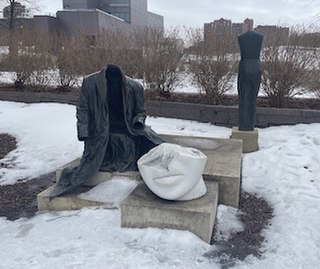
Judith Shea is an American sculptor and artist, born in Philadelphia, Pennsylvania, in 1948. She received a degree in fashion design at Parsons School of Design in 1969 and a BFA in 1975. This dual education formed the basis for her figure based works. Her career has three distinct phases: The use of cloth and clothing forms from 1974 to 1981; Hollow cast metal clothing-figure forms from 1982 until 1991; and carved full-figure statues made of wood, cloth, clay, foam and hair beginning in 1990 to present.
Martha Wilson is an American feminist performance artist and the founding director of Franklin Furnace Archive art organization. Over the past four decades she has developed and "created innovative photographic and video works that explore her female subjectivity through role-playing, costume transformation, and 'invasions' of other peoples personas". She is a recipient of two National Endowment for the Arts fellowships, a New York Foundation for the Arts fellowship, and an Obie Award and a Bessie Award for commitment to artists’ freedom of expression. She is represented by P.P.O.W. Gallery in New York City.
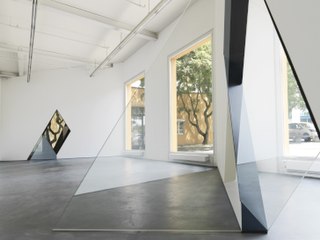
Sarah Oppenheimer is a New York City-based artist whose projects explore the articulations and experience of built space. Her work involves precise transformations of architecture that disrupt, subvert or shuffle visitors' visual and bodily experience. Artforum critic Jeffrey Kastner wrote that Oppenheimer's artworks "typically induce a certain kind of vaguely vertiginous, almost giddy uncertainty" that over time turns "indeterminacies of apprehension into epistemological uncertainties, epistemic puzzlement into ontological perplexity."

Ann Agee is an American visual artist whose practice centers on ceramic figurines, objects and installations, hand-painted wallpaper drawings, and sprawling exhibitions that merge installation art, domestic environment and showroom. Her art celebrates everyday objects and experiences, decorative and utilitarian arts, and the dignity of work and craftsmanship, engaging issues involving gender, labor and fine art with a subversive, feminist stance. Agee's work fits within a multi-decade shift in American art in which ceramics and considerations of craft and domestic life rose from relegation to second-class status to recognition as "serious" art. She first received critical attention in the influential and divisive "Bad Girls" exhibition, curated by Marcia Tucker at the New Museum in 1994, where she installed a functional, handmade ceramic bathroom, rendered in the classic blue-and-white style of Delftware. Art in America critic Lilly Wei describes Agee's later work as "the mischievous, wonderfully misbegotten offspring of sculpture, painting, objet d'art, and kitschy souvenir."
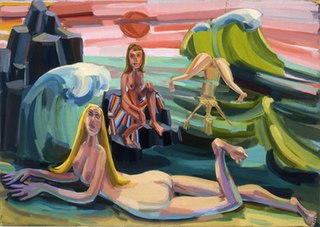
Judith Linhares is an American painter, known for her vibrant, expressive figurative and narrative paintings. She came of age and gained recognition in the Bay Area culture of the 1960s and 1970s and has been based in New York City since 1980. Curator Marcia Tucker featured her in the influential New Museum show, "'Bad' Painting" (1978), and in the 1984 Venice Biennale show, "Paradise Lost/Paradise Regained: American Visions of the New Decade." Linhares synthesizes influences including Expressionism, Bay Area Figuration, Mexican modern art and second-wave feminism, in work that flirts with abstraction and balances visionary personal imagery, expressive intensity, and pictorial rigor. Art historian Whitney Chadwick wrote, "Linhares is an artist for whom painting has always mattered as the surest path of synthesizing experience and interior life," her works "emerging as if by magic from an alchemical stew of vivid complementary hues and muted tonalities." Critic John Yau describes her paintings "funny, strange, and disconcerting," while writer Susan Morgan called them "unexpected and indelible" images exploring "an oddly sublime territory where exuberant bliss remains inseparable from ominous danger."

Erin M. Riley is a Brooklyn-based artist whose work focuses on women and women's issues primarily in hand-woven hand dyed wool tapestries. Riley's work challenges society's comfort level by displaying shocking images including nudity, drugs, violence, self harm, sexuality, and menstruation.
Meg Webster is an American artist from San Francisco working primarily in sculpture and installation art. While her works span multiple media, she is most well known for her artworks that feature natural elements. She is closely affiliated with Post-Minimalism and the Land Art movement and has been exhibiting her work since 1980.
Aneta Szyłak was a Polish art curator, art critic and art lecturer. She was the first director of the Łaźnia Center for Contemporary Art in Gdansk (1998-2001), founder and director of the Wyspa Institute of Art, organizer and first manager of Nomus - New Museum of Art. She curated exhibitions in Poland and abroad, animated the artistic life of Gdansk, and was the author or co-author of numerous publications on contemporary art.
Mary Lum is an American visual artist whose paintings, collages and works on paper reference the urban environment, architectural forms and systems. Critic John Yau writes, "Mary Lum’s paintings on paper are based on collages, which are made from things she uses or encounters in her everyday life as well as photographs she takes of the places she visits. "
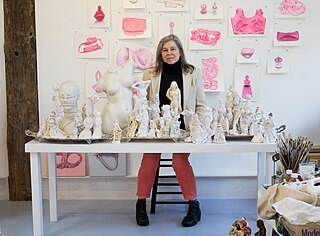
Portia Munson is an American visual artist who works in sculpture, installation, painting and digital photography, focusing on themes related to the environment and feminism. Her work includes large-scale agglomerations of mass-produced plastic found objects arranged by color, as well as small oil paintings of individual domestic found objects, and digital photographs of flowers, weeds and dead animals found near her home in upstate New York.

Janet Henry is a visual artist based in New York City.
Ann Pibal is an American painter who makes geometric compositions using acrylic paint on aluminum panel. The geometric intensity is one of the key characteristics that defines her paintings.

Fiona Connor is a visual artist from New Zealand, currently based in Los Angeles.
Guadalupe Maravilla, formerly known as Irvin Morazan, is a transdisciplinary visual artist, choreographer, and healer. At the age of eight, Maravilla was part of the first wave of unaccompanied, undocumented children to arrive at the United States border in the 1980s as a result of the Salvadoran Civil War. In 2016, Maravilla became a U.S. citizen and adopted the name Guadalupe Maravilla in solidarity with his undocumented father, who uses Maravilla as his last name. As an acknowledgment to his past, Maravilla grounds his practice in the historical and contemporary contexts belonging to undocumented communities and the cancer community. Maravilla's studio is located in Brooklyn, New York.

Katharine Kuharic is an American artist known for multi-layered representational paintings that combine allegory, humor, social critique, and aspects of Pop and pastoral art. Her art typically employs painstaking brushwork, high-keyed, almost hallucinogenic color, discontinuities of scale, and compositions packed with a profusion of hyper-real detail, figures and associations. She has investigated themes including queer sexual and political identity, American excess and suburban culture, social mores, the body and death. Artist-critic David Humphrey called Kuharic "a visionary misuser" who reconfigures disparate elements into a "Queer Populist Hallucinatory Realism" of socially charged image-sentences that shake out ideologies from "the congealed facts of contemporary culture" and celebrate the possibility of an alternative order.
References
- ↑ Levin, Kim (January 28, 1998). "Voice Choices: Maureen Connor, 'Love (at first) Site'". The Village Voice.
- ↑ Melrod, George (June 1993). "Lip Schtick (Janine Antoni, Maureen Connor, Rachel Lachowicz)". Art in America.
- ↑ John Simon Guggenheim Memorial Foundation. "Maureen Connor". Guggenheim Foundation. Retrieved 26 December 2018.
- 1 2 Social Practice Queens. "SPQ Faculty and Staff". socialpracticequeens.org. Queens College and the Queens Museum of Art. Retrieved 7 March 2015.
- ↑ Donovan, Thom (18 October 2011). "5 Questions for Contemporary Practice with Maureen Connor". Art 21 Magazine. Retrieved 7 March 2015.
- ↑ Dennis, Donna; Connor, Maureen (Summer 1981). "Environment As Memory: An Interview with Donna Dennis and Maureen Connor". Heresies (11).
- ↑ Princenthal, Nancy (April 1995). "Maureen Connor at the Alternative Museum and P.P.O.W.". Art in America.
- ↑ "Maureen Connor & Institute for Wishful Thinking". Alternativa. Archived from the original on 2 April 2015. Retrieved 7 March 2015.
- ↑ "A.I.R. Gallery looks at Reproduction Rights in the USA". 9 May 2022.
- ↑ "At Frieze, a 45-Foot Herb Garden is an Unlikely, and Highly Effective, Visualization of the Threat to Women's Reproductive Rights". 19 May 2022.
- 1 2 3 4 5 Mansfield, Elizabeth C., ed. (2007). Connor, Maureen, (Con)testing Resources, in Making Art History: a Changing Discipline and its Institutions. Routledge. pp. 245–263.
- ↑ Jahn, Marisa, ed. (2010). Byproduct: On the Excess of Embedded Art Practices, "Aftermaths and Personnel, A Conversation Between Maureen Connor and Marisa Jahn". YYZ Books.
- ↑ Felshin, Nina (Spring 1995). "Women's Work: A Lineage 1966-94". The Art Journal. doi:10.1080/00043249.1995.10791681.
- ↑ Johnson, Ken (January 19, 2001). "Art in Review: Maureen Connor, Seductions and Games, Queens Museum of Art". The New York Times. Retrieved 7 March 2015.
- ↑ "Maureen Connor". ZKM Center for Art and Media. Retrieved 26 December 2018.
- ↑ "5 Questions for Contemporary Practice with Maureen Connor". Art21 Magazine. 18 October 2011. Retrieved 2020-12-02.
- ↑ "Thinner Than You - You are Beautiful..." sites.google.com. Retrieved 2020-12-02.
- ↑ "Connor, Maureen - Thinner Than You". dla.library.upenn.edu. Retrieved 2020-12-02.